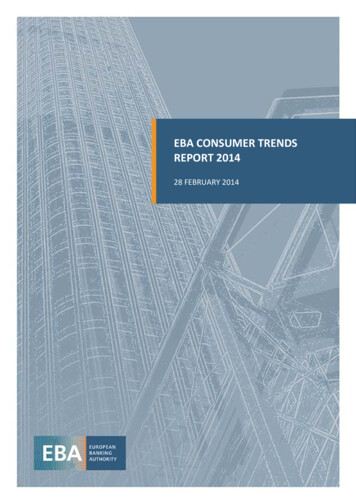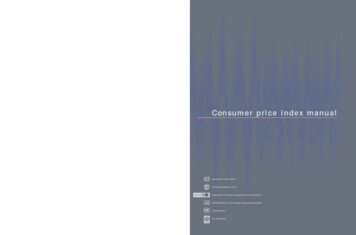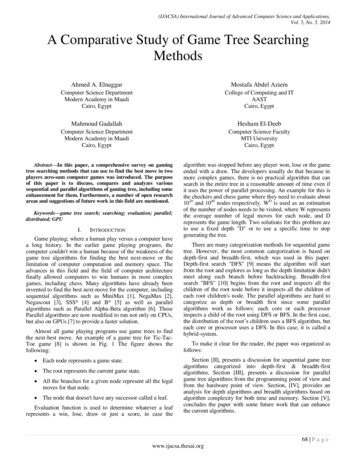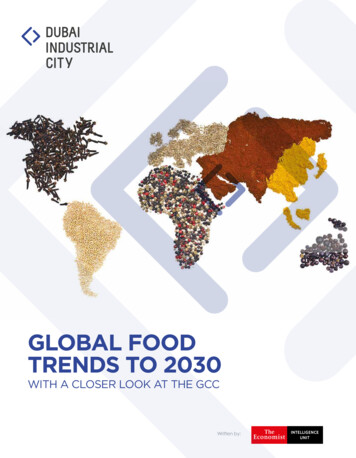
Transcription
Five Game-ChangingConsumer Trends
indexMillennials: drivers of a new consumption era4Digitally “mobile”-savvy consumers10Personalized experience and on-demand shopping16The rise of the sharing economy22A focus on health and wellness28Appendix: Data sources352Consumer TrendsSources: See appendix; KPMG analysis
introductionConsumer trends are evolving faster than ever. And it’s never beenmore important—or challenging—for entrepreneurs to keep in frontof these trends, if they hope to compete and grow.At BDC, we understand this challenge. As Canada’s only bank exclusively devoted to entrepreneurs, it’s our job tomake your job easier, so you can focus on what you do best: taking care of business.In this new document, we update the findings of our popular 2013 study Five Game-Changing Consumer Trends,which was one of the most widely read reports BDC has ever produced.Here’s what we found in 2016:➀➁➂➃➄Millennials drive consumer revolution—Millennials, the hyper-connected generation of young peopleborn from 1980 to 2000, are driving a profound transformation in habits among all consumers. Theytend to be frugal, savvy shoppers and not particularly brand loyal.Mobile rules—Canadians love their mobile devices more than ever, especially for shopping. It’s vital forbusinesses to not only be online, but also to offer a mobile-friendly website.One size doesn’t fit all—Consumers increasingly demand the personal touch. Targeting customers withcustomized messages and personalized experiences significantly improves results.We like to share—Canadians have embraced the 15-billion global sharing economy, using serviceslike Uber, Airbnb and others to save money.Canadians are more concerned about their health—a trend that just keeps strengthening. The focuscuts across ages, pushing consumers to seek natural products and healthier foods.How should you respond to these major trends? With the help of case studies and research, we explain howthe changes in consumer behaviour affect your business, what opportunities they present and some of thestrategies you can use today to take advantage to make your business more competitive.This report was prepared by the Research and Economic Analysis team of BDC’s Marketing and Public Affairsdepartment. Reliance on and use of this information is the reader’s responsibility. We would like to thank KPMGfor its participation in preparing this document.Sources: See appendix; KPMG analysisConsumer Trends3
➀4Consumer TrendsMillennials:drivers of a newconsumption eraSources: See appendix; KPMG analysis
Millennials: a connected generation looking forextraordinary experiencesWho are they?Born between 1980 and 2000 (16 to 36 years old), millennials are also referred to as “Generation Y” andrepresented about 9.9 million Canadians in 2014 (28% of the population). By 2020, Gen Y members will be20 to 40 years old and they will have worked their way up the career ladder.The connected generationSpending patternsParticularly active online, millennials are what we call“the connected generation.” They shop online and usesmartphones and mobile devices. Their purchases areinfluenced by what they read on social media.Since a majority of millennials are ready tospend more to stay ahead of trends and are notparticularly brand loyal, brands and retailers willhave to continuously and quickly reinvent their offer,experience and brand story to offer these clients theexperience they are looking for. Smartphone usage: 81% millennials vs. 72% Gen Xand 46% boomers Staying informed through social networking:66% millennials vs. 53% Gen X and 40% boomers Shopping online: 92% millennials vs. 82% Gen Xand 74% boomers Millennials are frugal when it comes to spendingon convenience products and saving money.However, they do not hesitate to spend onextraordinary experiences. Fifty-seven per cent of millennials are willing tospend more in order to stay ahead of trends;56% of them also claim they are not brand loyal.Gen X: fewer in number, but at the peek of their careersWho are they?Born between 1966 and 1979, Generation X represented more than 6.2 million Canadians in 2014(17% of the population). Gen Xers entered the workforce during an economic downturn and are currentlyat the peak of their careers and earning years. Although less “connected” than millennials, their consumerbehaviours are closer to those of the younger generation than the baby boomers.Sources: See appendix; KPMG analysisConsumer Trends5
Baby boomers still have more spending power in the short termWho are they?Born between 1946 and 1965, they started their careers in the late 1970s. The oldest baby boomers haverecently reached retirement age and millions more will join them in the coming years. They representedmore than 9.5 million Canadians in 2014 (27% of the population).Purchasing powerGen X and baby boomers have more purchasingpower but millennials influence the other generations’purchasing habits. In 2010, the average disposable income of In 2011, two in five young adults (20 to 29 yearsCanadians between 50-54 was 44K vs. 41K forthose between 40 and 44 years old and 28K for25- to 29-year-olds. Within a decade, baby boomers will control over70% of the wealth in Canada.old) were living with their parents, compared to aquarter in 1981. Millennials are trendsetters and are very activeon social media; consequently, they influence theother generations’ purchasing habits.Business strategiesImprove your customer experience through every channelWith lower brand loyalty among millennials, customer experience has become even more crucial.Companies need to focus their efforts on:Companies could benefit from: understanding their current and targeted getting products and services to consumers when managing and exceeding customer expectations analyzing consumer data and insights to provideclients’ needs;at every step of the customer path/experience; first, understanding the different steps—consideration, evaluation, purchase andpost-purchase; then, understanding customer expectationsat each step; finally, identify improvement opportunitiesto minimize customer effort; andand where they want them;a targeted and meaningful journey; and keeping it simple and convenient throughoutall channels. use individualized attention to drive loyalty(for example, by sending individual personalizedofferings).6Consumer TrendsSources: See appendix; KPMG analysis
Develop a strong brandCompanies need to develop a brandwith a strong story aligned to theirdifferent clienteles.Companies need to adapt their marketingstrategies to better address consumers’evolving behaviors. connect your brand with what your clients value create outstanding content—be appealing,most (status, adventure, excitement, travel,wellness, etc.); and create brand awareness and manage socialmedia, since consumers’ purchasing decisions areinfluenced by family, friends end strangers morethan “experts.”with informational and actionable content; think mobile first; incorporate videos; focus on simplicity—simpler is better; empower personal expression by allowingco-creation; ensure honesty, transparency andtrustworthiness; and be active where your clients are (on the trendiestsocial media like Snapchat, Peach, etc.) and speaktheir language (e.g., hashtag, emoji, etc.).Sources: See appendix; KPMG analysisConsumer Trends7
COOKITboutique.comFrom millennials to working momsand foodie boomersLaunched in 2014, COOK IT is changing Quebec consumers’ mindsetstowards a digital, convenient, healthy and fun way to prepare dinner.Inspired by Europeans’ and New Yorkers’ appetites for online food ordering, and fueled by her passion for food,social media and entrepreneurship, Judith Fetzer launched COOK IT in June 2014.COOK IT delivers chef-designed and ready-to-cook recipes to your front door with a vacuum-sealed kitof fresh ingredients.Value proposition: weeknightcooking, fun and simplifiedWith fresh and local pre-packaged ingredients,prepare chef-designed, home-cooked meals thatyou’ll be proud of in less than 30 minutes.Business modelCOOK IT’s business model can be complex:Each box is different and 1,000 are deliveredeach week. Execution requires clear, rigorous andefficient processes.To keep the portion price reasonable, COOK ITnegotiates the lowest possible food cost with localsuppliers. However, each order has a minimumquantity of four portions to allow a certain salesvolume for COOK IT.The subscription model increases revenue recurrenceOriginally, the COOK IT customer was typically ayoung urban professional, social mediapower-userand foodie working in a very creative environment(e.g., start-up, PR agency, etc.).With the subscription model and the “buzz” createdby the younger generation, COOK IT enlarged itsclientele to young wealthy families (busy workingfoodie parents interested in health and “DIY”) andeven foodie boomers ( 20%) who have more time andinterest for a cook-it-yourself offer.“We see aprogressiveshift from trendyand connectedmillennials tofoodie workingmoms!”8Consumer TrendsCOOK IT brand and value proposition attributes fitperfectly with millennials’ expectations and alsoapply to older foodies! A convenient and fun “do-it-yourself” approach A community to join and experiences to shareon social media A passion for local, quality food Continuous innovation (different seasonal recipesevery week, designed by Montreal chefs) A recognition program for super-usersSources: See appendix; KPMG analysis
Ambition and keygrowth priorities–– Extend delivery to the entire province ofQuebec, and even to Ontario (2017)–– Extend the menu portfolio with moreentrées and desserts, a “week kit” andgluten-free recipes–– Launch an online store to sell local produceand artisan productsTips for entrepreneurs!–– Invest in you brand image with anappealing logo, professional pictures anda “story to tell”–– Embrace the digital shift to the maximum(including mobile platforms)–– Manage you social media with anauthentic approach–– Create proximity with your customersthrough excellent customer service andcommunity buildingSources: See appendix; KPMG analysisKey successfactors Build a strong and tight “COOK ITcommunity” around foodies of all ages Increase brand awareness with amultichannel PR communication strategy(TV interviews, press, blogs, radio,social media) Leverage social media with a low budget(authentic 2.0 approach), using Facebookto collect data and create a community andInstagram to increase the conversion rateand share experiences Be a digitally multiplatform mobile player(responsive site) A strong customer service team withpersonalized service No compromise on food quality Engage and diversify clientele througha subscription modelConsumer Trends9
➁10Consumer TrendsDigitally “mobile” –savvy consumersSources: See appendix; KPMG analysis
Canadians are increasingly digitally savvy and havehigher expectationsAmong its G8 counterparts, Canada ranks second in terms of internet penetration. However, Canadianbusinesses are falling short of the digital shift. Canadian businesses rank seventh in terms ofinformation technology (IT) spending; they invest42% less than their American counterparts. Ninety per cent of consumers systematically visit acompany’s website before sending them an emailor calling for information. By 2020, specialists predict that customerswill manage 85% of their relationship with anenterprise without interacting with a human.Mobile consumers are reshaping the shopping journeyIn a consumption context, smartphone use is growing.Immediate access to information influencespurchasing decisions and shopping experiences atevery step of the process.PrepurchasePurchasePostpurchase–– Forty-one per cent of Canadiansseek inspiration online; 35%prepare their physical purchaseahead of time by selecting itemsto buy, checking availability at thestore, etc.–– Eighty-two per cent of Americansmartphone users consult theirphone at the store for purchasesthey are about to make.–– One-quarter of American shopperschange their minds about buyingan item while in the checkout line,after reading a review on theirsmartphone.–– In the United States, one out ofthree purchases from a company orbrand other than the one intendedhappen because of informationreceived via smartphone.–– Canadians use their phones asa payment device at a merchantlocation increasingly more often(28% in 2014 vs. 12% in 2012).–– Thirty-eight per cent of consumersGen X: smartphone andtablet adoption is explodingSmartphones: Four out of every fivemobile users own a smartphone (vs. a basiccell phone).Tablets: More than one out of fourCanadians owns a tablet.Millennials spend half their online time ona smartphone and 11% on a tablet.B2B companies aredigital-savvy too Over half (57%) of the B2B buying processis done prior to engaging with sales.Pressures from industry leaders to moveto online platforms are driving the B2Bretailing digital shift.For example:Expectation among B2B companies to buyand sell onlineShift to conduct procurement transactionsover the internetGrowing interest of companies in placingorders through mobile commerceuse their smartphone to checktheir online order status.Sources: See appendix; KPMG analysisConsumer Trends11
Consumers expect a mobile-responsive site at leastMobile-responsive websites are now practically a must-have for consumers. With increased usage, mobile appsare already shaping future consumer needs. A majority of consumers say it is easier for them Eighty-five per cent of people prefer native mobile Smartphone users spend a majority of their mobile A majority of leading American and Europeanto find information on mobile-optimized sites; overone-quarter of consumers claim they will simplyleave a site if it is not mobile optimized.digital media time using mobile apps. In 2015, theaverage time spent on an app increased by 21%.apps (coded in a specific programming languageto increase performance and convenience) tomobile websites.companies have a mobile commerce (M-Com)website and half have a M-Com app on iOS.Business strategiesOptimize your digital and mobile presence to increase salesand awarenessTo fully embrace the digital shift, businesses should have an optimized multiplatform presence, through relevantapplications, social media channels, and above all, a high-performance, speedy and responsive website.Today’s leading practices include:Must-have:Nice-to-have: An online presence clearly describing the product A landing page with reassuring information,and service portfolio and contact information High-performance referencing through integratedSEO and SEM strategies to increase traffic For B2B companies, a high-performance andsecured transactional website, which acts as asales tool and assists in the buying process, is amust-have. Standard functionalities include placingorders through mobile commerce devices. A responsive mobile site is a must-have for amultiplatform presence. Mobile-designed sites andmobile apps will shape future consumer needs.an inspirational style and relevant content andfunctionalities (e.g., list of viewed items, storelocator, etc.) A friendly user interface with a fast navigationbar and an easy-to-use search engine withpre-suggestions and smart filters, etc. to increaseconvenience High-quality content marketing—rich, inspirationalcontent (e.g., blogs, tutorials, tips, tests, how-tovideos, etc.) to increase credibility Highly available customer support (live chat,call centre) to reassure customers12Consumer TrendsSources: See appendix; KPMG analysis
PrepurchaseCustomer expectationsBusiness differentiators–– Getting specific information onBeing present and top-of-mind via:products and services–– Getting inspired by the offer–– Getting an experience that’s similarto the in-store experience on theplatform of their choice–– Getting tips and advice–– Being given access to “evaluate” and–– Relevant, actionable and mobile-friendlycontent–– Pertinent social media presence(Instagram, Snapchat, etc.)–– Appealing video content“compare” optionsPurchase–– Making their payment quickly,safely and intuitively–– Customizing their transaction(e.g., flexible delivery options)–– Getting free delivery wheneverpossibleOffering efficiency enablers such as:–– App-embedded wallet–– Easy checkout (e.g., 1-click on Amazon)–– Live or video chat (customer service)–– Multiple payment methods (e.g., PayPal)–– Getting support and answers toquestions from customer servicePostpurchase–– Confirming processed orders andEngaging with client post-purchasethrough:–– Getting fast and reliable delivery–– Order confirmation emails, dispatch–– Personalizing customer service–– Mobile shipment tracking function–– Personalized loyalty incentive programstracking order progressservice(including easy returns)–– Sharing their experience withemails and online satisfaction surveysother customersSources: See appendix; KPMG analysisConsumer Trends13
Studio F/XEmbracing the digital shiftto grow and diversify clienteleCreated in 1999, Vancouver-based Studio F/X sells professional specialeffects make‑up in store and online across Canada.Originally a cosmetic retail store serving 30- to 60-year-old women from Vancouver, Studio F/X saw a need forthe special effects niche with the increasing interest of production companies filming movies and TV shows in theVancouver area. Studio F/X moved to a bigger retail space offering a shop-in-a-shop special effects studio.With the shift to special effects, Studio F/X’s clientelecompletely changed. Ninety per cent of its currentclients are now from the artistic scene (actors, movieproducers, theater schools, operas, drag queens,ComicCon artists and convention participants, etc.),and its share of wallet increased (its average order isnow 3,000 per customer).Two years ago, owner Carla Antrobus launched atransactional online store to expand the businessbeyond the local market in order to increasesales growth.Online sales now represent 30% of Studio F/X’sbusiness, and keep growing!Studio F/x’s clients are Canadianartists, performers, cosmeticsenthusiasts and TV and movieproducersStudio F/X made large investments in itsdigital strategy. Development of an in-house online platform,including user-friendly site navigation and theintegration of rich content to improve the userexperience SEO strategy based on AdWords and keywordsto improve the site’s search engine ranking Development of a fully mobile-responsive siteThrough its online platform, Studio F/X has morein-store traffic.The digital experience crosses the entireshopping path.“My businessstarted toskyrocket whenI went digital!” Pre-purchase: purchasing online offers the samein-store purchase experience (easy, convenient,visual, edgy) Purchase and payment: Studio F/X accepts allpayment methods. PayPal gave a significant boostto online sales. “Adding PayPal was the best thingI ever did!,” says Carla. Post-purchase and delivery: Studio F/X offersfree shipping for orders over 100. Orders areshipped within 24 hours and can be trackedby customers.14Consumer TrendsSources: See appendix; KPMG analysis
Ambition and keygrowth priorities–– Growing annual sales to 1M–– Improving their SEO strategy–– Embracing the big data movementto increase sales and better targetcustomers’ needs–– Considering a mobile appTips for entrepreneurs!–– Don’t be afraid of going digital! It costsmoney but in the end, the ROI isphenomenal! Digital is the future of retail.We have to embrace the future.–– Provide all payment methods and offerKey successfactors A strong customer service to answerclients immediately Customer service is the most importantfactor in store and online A mobile platform with a fully responsive site Every single person has a cell phone.People make their orders from it!With over 400 clients a day viewingan average of 10 pages on the onlinestore each, Studio F/Xs’ biggestchallenge is converting their shoppingexperience into purchases.strong customer service.–– Be consistent in every channel(in store, online, mobile) and through theshopping path.Sources: See appendix; KPMG analysisConsumer Trends15
➂16Consumer TrendsPersonalizedexperienceand on-demandshoppingSources: See appendix; KPMG analysis
Consumers want personalized attention:One size does not fit allCustomers expect more and more personalized interaction on all platforms, as well as customized offerings tomake their shopping experience more relevant.Personalization has a positive impact onpurchasing decisions and basket size. Three quarters of American consumers prefer todo business with brands that use their personalinformation to make their shopping experiencesmore relevant to them. Close to nine in ten American consumers say thatpersonalization influences what they purchase. Fifty-one per cent of Canadian and Americanconsumers spend more when presented witha personalized e-commerce offer.Nearly two in five Canadians spend over five hoursper week streaming on-demand content. The youngerthe consumers, the more acute the trend (86% ofmillennials vs. 53% of 55 ).Sixty per cent of American internet users would payfor same-day delivery. In the US, several retailers, such as Amazon, offerone-hour delivery services in selected metro areas. In Canada, Canada Post launched same-daydelivery service in selected Canadian cities. In America, businesses that personalized webexperiences and tracked their sales improvementreported a 19% increase on average. Over half of US retailers that use automatedproduct recommendations see their averageorder value increasing year over year.Personalized emails are well perceived byconsumers as long as they’re relevant. In North America, triggered email messages get119% higher click-through rates than “business asusual” messages. Half of North American consumers say thatretailers send them emails with irrelevantinformation. Eight in ten American consumers who agreedto receive emails from a company wouldn’t mindreceiving more as long as they take into accountpast shopping habits.Sources: See appendix; KPMG analysisThe cult of immediacy:on-demand!Instant access to virtual goods hasimpacted consumer behavior overall.Consumers’ “on-demand” behaviours areenabled by applications that aggregatedemand on mobile devices and then fulfill itthrough physical (non-virtual) services suchas transportation, dining, delivery, homeand professional services, etc.Some companies that provide on-demandservices have diversified their deliverybusiness models and now offer homedelivery, click-and-collect, and hybridservices (mix of home delivery and clickand-collect, like Canada Post’s FlexDeliveryservice).Consumer Trends17
Click-and-collect services (i.e. online purchasesshipped to a brick-and-mortar location and picked upduring business hours) are growing in popularity. Advantages: It drives traffic into the store with nosubsidizing of delivery costs, and keeps the clientexperience under control. Canadian retailers such as Rona and Home Depothave opted for this model.The proliferation of product customization andpersonalization is encouraging the manufacturersof established brands to adjust their manufacturingpractices in order to embrace product customizationand combine standard lean principles with made-toorder (MTO) tactics to maintain profitability. Progressin manufacturing technologies (such as flexiblemanufacturing, 3D printing, etc.) is enabling masscustomization at lower costs, allowing manufacturersto completely rethink traditional manufacturing andsupply chains.Business strategiesOffer one-to-one marketingA one-to-one approach to customer interactionallows businesses to provide higher value to theircustomers. Such an approach focuses on deliveringrelevant and customized data-driven content.Deep customer insight can only be gained througheffective data analysis. Data can be obtained throughdifferent sources, such as complaints, mystery clients,customer surveys, customer suggestions and socialmedia insights.Use data insights to implementpersonalized marketing tactics, including: exclusive offers and deals based on user profile,previous purchases and browsing history; triggered emails to provide relevant, timely andpersonalized information; customized newsletter content anddelivery frequency; personalized product recommendations based onprevious purchases or browsing history; customized loyalty incentives based onconsumer data; and cross-selling techniques based onuser-tailored data.18Consumer TrendsSources: See appendix; KPMG analysis
Rethink the traditional manufacturing modelTo mitigate the risk and disadvantages associated with increased product personalization (e.g., decreasingprofitability, counterproductive variety, higher inventory turnover, complex production, costly SKUs portfolio, etc.),manufacturers should rethink their operating business model. Some best practices include: selecting the product features that will trulyadd value in customers’ minds, while limitingunnecessary supply; avoiding overloading consumers with choices; optimizing the SKU portfolio by focusing on topproducts; and offering simple extensions or personalization of thebasic products that are kept. involving consumers in product creation;Embrace the on-demand shiftMore and more, successful businesses will be able to deduct customer expectations from on-demand shopping.Industries like transportation, food services, grocery and personal services already take advantage of this trend.Determine the model that is most adaptedto your customers’ needs: home delivery; click-and-collect; or a mix of both models, to different degrees andwith different characteristics, in order to maximizethe desired results.Other aspects to consider: Marketing: What is the optimal product offeringand pricing/promotional strategy? Logistics and operations: What is the optimaltransportation model and warehouse anddistribution model? IT: What is the best way to keep your IT platformsup to date? Financial: What is an acceptable timeline torecoup investments (such as free shipping costs)?Sources: See appendix; KPMG analysisConsumer Trends19
BonlookDisrupting the prescription eyewearindustry with a competitive offerLaunched in 2011, Bonlook sells unique, affordable and trendy prescriptionEyewear online.Bonlook’s mission is to change the way people look at and shop for glasses, giving them the eyewear wardrobesthey never knew they wanted or could have. Bonlook is revolutionizing the eyewear omni-channel experiencewith its fashion-forward line of prescription frames coupled with an impeccable and homogeneous virtual andphysical customer experience.Bonlook’s business model is built on trendy glasses atan accessible cost and great customer service. Thecompany has significantly reduced the cost of glassesby eliminating the middleman.Bonlook offers more than 250 trendy glassesdesigned in Montreal and manufactured overseas.From a purely online business, the company nowcounts on a growing number of retail locations. The“brick and mortar” benefits are fittings, personalizedassistance and free adjustments by Bonlook opticians.Four levels of customized service:“Each order is unique!”➀ Customized product: The glasses collectionis tailored to all sorts of face shapes andprescriptions.➁ Customized web navigation: Web navigation iscustomized to geographic location (language andcurrency), and will soon be optimized for gender,profile, age and buyer history. Bonlook also offersa virtual “try on” tool, available online and onmobile devices.➂ Email segmentation: Bonlook has developed analgorithm for email customization depending ondifferent customer profiles (e.g., gender, location,purchase history, etc.).➃ Personalized purchasing experience: Eachcustomer may have a unique path through thedifferent channels (e.g., from social media towebsites, from kiosk to online, etc.).20Consumer TrendsSources: See appendix; KPMG analysis
Ambition and keygrowth priorities–– Bonlook anticipates strong revenue growthfor 2016. The company will soon openboutiques in shopping malls, as extensionsof the online store.–– A footprint expansion is planned in Canada.In a few years, do not be surprised to seeBonlook in the US Key successfactors forefficientcustomization“At least 50% of our success comesfrom the back office”Tips for entrepreneurs! Be operationally driven, with a–– Do not neglect back office vs. front office! Have a solid IT platform and team as well asOperations and technology are crucialto ensure successful, fast and precisedeliveries. Successful players ensure theycontrol their logistics/ operations, and theyuse and leverage a great web platform /data analytics.solid andefficient back-office teama strong and reliable customer database Offer a consistent omni-channel experienceand presence (mobile, web, social mediaand showroom) Offer fast delivery Offer accessible customer serviceSources: See appendix; KPMG analysisConsumer Trends21
➃22Consumer TrendsThe rise of thesharing economySources: See appendix; KPMG analysis
Share products or services instead of owning themCollaborative or “sharing” economycompanies operate under a neweconomic model where ownershipand access is shared betweencorporations, start-ups and people.These companies often offer platformsthat seek to match independentsupply with demand in real time.People get the products and/orservices they want from each other,rather than from established brands,which used to be their only options.ConsumersProvidersPlateformsRent, buy, orutilize resourcesdirectly fromprovidersOrganize the poolof available resourcesand connectconsumers withprovidersIndependentsellers, renters,freelancers,makers, etc.A majority of consumers are expected to participate in thesharing economyOver half of North America
In this new document, we update the findings of our popular 2013 study Five Game-Changing Consumer Trends, which was one of the most widely read reports BDC has ever produced. Here's what we found in 2016: Millennials drive consumer revolution —Millennials, the hyper-connected generation of young people










